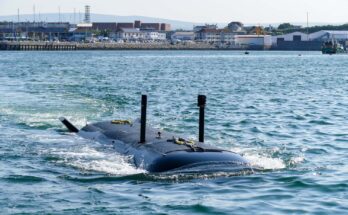The British Royal Air Force (RAF) received the first of an eventual nine P-8A Poseidon maritime patrol aircraft (MPA) from U.S. aerospace giant Boeing at an official ceremony in Seattle on October 30. An RAF aircrew will begin training with the aircraft at Naval Air Station Jacksonville in Florida. In 2020, after training has been completed, the plane will be flown to the U.K., where it will be stationed at RAF Lossiemouth in Scotland with 120 Squadron.
She's on her way! Our 1st Poseidon MRA.1 maritime patrol aircraft has taken off from Seattle and is on her way to @NASJax_ for formal handover to UK ownership @UKdefUSA @P8A_PoseidonRAF @CXXSquadron @RAFLossiemouth pic.twitter.com/290Zz8vkBZ
— Royal Air Force (@RoyalAirForce) October 30, 2019
Handover of the aircraft marks a belated return to British fixed-wing MPA capability lost when the former Conservative-led government of Prime Minister David Cameron opted to forgo bringing the Nimrod MRA4 maritime patrol aircraft into service under its 2010 Strategic Defence and Security Review (SDSR). At the time, the government cited GBP2 billion in potential savings that would be accumulated over 10 years by cutting the Nimrod MRA4 from its list of procurement programs.
The Nimrod program – which dates back to 1996 with the goal of acquiring 21 MRA4s before the total was reduced (twice) to just nine – was indeed one of the most botched defense procurement projects in the Ministry of Defence portfolio at the time. Already overdue, the Nimrod program had continued to shrink in capacity while continuing to climb in cost. Estimates in 2010 showed that the MoD would end up paying more than GBP3.9 billion (and as much as GBP4.5 billion) for just the nine aircraft – less than half the unit number initially planned and at a higher cost than under the original 1996 agreement with BAE Systems.
Added to the cost overruns and poor program management was the negative perception of the Nimrod platform following the mid-air explosion in September 2006 of an older Nimrod MR2 variant over Kandahar in Afghanistan. The explosion – caused by fuel leaking into hot air ducts – resulted in the loss of 14 service personnel. The coroner investigating the crash tartly commented that none of the Nimrod fleet had been airworthy since originally entering service in 1969. While the MRA4 was virtually an entirely different aircraft than the MR2, it could not shake the sour view of the program.
Ultimately in January 2011, the nine MRA4s were chopped up by private contractors and sold for scrap. The U.K. National Audit Office (NAO) published a report on November 16, 2011, citing the total cost of the Nimrod MRA4 program to the MoD as GBP3.4 billion – with nothing to show for it.
Worse, a dedicated fixed-wing platform performing a series of roles including intelligence, surveillance, target acquisition, and reconnaissance (ISTAR), not to mention protection of the Royal Navy’s submarine nuclear deterrent and maritime task forces – and long-range search-and-rescue (SAR) functions – was now lacking.
During this period, however, the RAF worked to retain its maritime surveillance skills through the Seedcorn initiative, which placed around 30 ex-Nimrod aircrew with the United States Navy with the idea of providing a bridge for reconstituting the MPA role.
Under the succeeding SDSR unveiled in November 2015, the U.K. announced it would be bringing back the fixed-wing maritime patrol capability via the purchase of nine P-8As through the U.S. government-to-government Foreign Military Sales (FMS) mechanism. The official British FMS request was approved by the U.S. State Department, with notification sent to Congress by the Pentagon’s Defense Security Cooperation Agency (DSCA) on March 24, 2016.
At the Farnborough Airshow on July 11, 2016, the British MoD moved forward with the purchase, placing an order for the nine P-8As at a cost of over GBP3 billion.
The RAF hopes to have its first three P-8s in service in 2020, which would coincide with Initial Operational Capability (IOC) of the first of two aircraft carriers, HMS Queen Elizabeth, with the Royal Navy. Deliveries are expected to wrap up by 2022.

Dan Darling is Forecast International’s director of military and defense markets. In this role, Dan oversees a team of analysts tasked with covering everything from budgeting to weapons systems to defense electronics and military aerospace. Additionally, for over 17 years Dan has, at various times, authored the International Military Markets reports for Europe, Eurasia, the Middle East and the Asia-Pacific region.
Dan's work has been cited in Defense News, Real Clear Defense, Asian Military Review, Al Jazeera, and Financial Express, among others, and he has also contributed commentary to The Diplomat, The National Interest and World Politics Review. He has been quoted in Arabian Business, the Financial Times, Flight International, The New York Times, Bloomberg and National Defense Magazine.
In addition, Dan has made guest appearances on the online radio show Midrats and on The Media Line, as well as The Red Line Podcast, plus media appearances on France 24 and World Is One News (WION).




